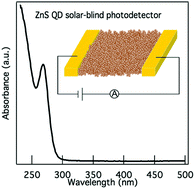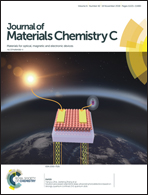Solution-processed solar-blind deep ultraviolet photodetectors based on strongly quantum confined ZnS quantum dots†
Abstract
Solar-blind deep ultraviolet (DUV) photodetectors (PDs) have promising applications in a variety of fields due to the zero background under sun or room illumination. As almost all solar-blind DUV PDs are fabricated based on materials prepared by expensive high temperature and vacuum methods, therefore, solution processed devices are highly desirable for large area, flexible and arrayed applications. Here, we demonstrated that solar-blind DUV PDs can be fabricated using colloidal ZnS quantum dots (QDs). In order to synthesize ZnS QDs with a bandgap in the solar-blind region, a new synthesis was developed. The new method produced monodispersed and strongly quantum confined ZnS QDs with an exciton peak at 265 nm. Solar-blind DUV PDs were fabricated via spin coating and ligand exchange. The ZnS QD solar-blind DUV PDs showed a fast response (Tr = 0.35 s, Td = 0.07 s) and good responsivity (∼0.1 mA W−1) and the performance was comparable to other solar-blind DUV PDs based on some traditional wide bandgap semiconductor materials. The response of the ZnS QD PDs was found to be dominated by the drift of the photogenerated carriers, as the ZnS QD thin film was insensitive to their surface states.



 Please wait while we load your content...
Please wait while we load your content...